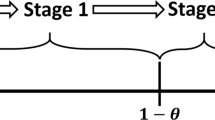Abstract
This paper estimates the potential social cost of trade barriers using the Harberger and the Tullock/Posner approaches for a sample of U.S. food and tobacco manufacturing industries. In addition, it tests the relationship between the computed welfare losses and special-interest political activity (PAC contributions). If all rents were dissipated through rent seeking, the social cost of trade barriers would be about 12.5 percent of domestic consumption and would be particularly large for sugar and milk products where quotas are the main instrument of protection. Furthermore, the results indicate that welfare losses are positively associated with industry lobbying but the strength of such association is strongly dependent on industry concentration.
Similar content being viewed by others
References
Baldwin, R.E. (1984). Rent-seeking and trade policy: An industry approach.Weltwirtschaftliches Archiv 120(4): 662–677.
Bhagwati, J.N. (1982). Directly unproductive, profit-seeking (DUP) activities.Journal of Political Economy 90 (October): 988–1002.
Brecher, R.A. (1982). Comment on “Endogenous tariffs, the political economy of trade restrictions, and welfare.” In J.N. Bhagwati (Ed.),Import competition and response, 234–238. Chicago: University of Chicago Press.
Brooks, M.A. and Heijdra, B.J. (1989). An exploration of rent seeking.The Economic Record 65 (March): 32–50.
Cowling, K. and Mueller, D.C. (1978). The social cost of monopoly power.Economic Journal 88 (December): 727–748.
Donnenfeld, S. and Weber, S. (1985). Lobbying for tariffs and the cost of protection.Recherches Economiques de Louvain 51 (March): 21–27.
Dougan, W.R. (1991). The cost of rent seeking: Is GNP negative?Journal of Political Economy 99 (June): 660–664.
Esty, D.C. and Caves, R.E. (1983). Market structure and political influence: New data on political expenditures, activity and success.Economic Inquiry 21 (January): 24–38.
Fisher, F.M. (1985). The social cost of monopoly and regulation: Posner reconsidered.Journal of Political Economy 93 (April): 410–416.
Gisser, M. (1986). Price leadership and welfare losses in U.S. manufacturing.American Economic Review 76 (September): 756–767.
Harberger, A. (1954). Monopoly and resource allocation.American Economic Review 44 (May): 77–87.
Krueger, A.O. (1974). The political economy of the rent-seeking society.American Economic Review 64 (June): 291–303.
Laband, D.N. and Sophocleus, J.P. (1988). The social cost of rent seeking: First estimates.Public Choice 58 (September): 269–275.
Makinson, L. (1990).Open secrets: The dollar power of PACs in Congress. Center for Responsive Politics, Congressional Quarterly Inc., Washington, DC.
Olson, D. and Bumpass, D. (1986). An intertemporal analysis of the welfare cost of monopoly power: U.S. Manufacturing 1967–81.Review of Industrial Organization 2(3): 308–322.
Pagoulatos, E. and Sorensen, R. (1986). What determines the elasticity of industry demand?International Journal of Industrial Organization 4: 237–250.
Pittman, R. (1988). Rent-seeking and market structure: Comment.Public Choice 58 (August): 173–185.
Posner, R.A. (1975). The social cost of monopoly and regulation.Journal of Political Economy 83 (August): 807–827.
Siegfried, J.J. and Tiemann, T.K. (1974). The welfare cost of monopoly: An inter-industry analysis.Economic Inquiry 12 (June): 190–202.
Tollison, R.D. (1982). Rent seeking: A survey.Kyklos 35(4): 575–602.
Tullock, G. (1967). The welfare cost of tariffs, monopolies, and theft.Western Economic Journal 5 (June): 224–232.
U.S. Department of Commerce, Bureau of the Census. (1991).1987 Census of Manufacturers: General Summary. Washington, DC.
U.S. International Trade Commission (1990a).Estimated tariff equivalents of U.S. quotas on agricultural imports and analysis of competitive conditions in U.S. and foreign markets for sugar, meat, peanuts, cotton, and dairy products. U.S.I.T.C. Publication 2276, Washington DC.
U.S. International Trade Commission. (1990b).The economic effects of significant U.S. import restraints, phase II: Agricultural products and natural resources. U.S.I.T.C. Publication 2314, Washington DC.
Varian, H.R. (1989). Measuring the deadweight costs of DUP and rent-seeking activties.Economics and Politics 1 (Spring): 81–95.
Wenders, J.T. (1987). On perfect rent dissipation.American Economic Review 77: 456–459.
Willner, J. (1989). Price leadership and welfare losses in U.S. manufacturing: Comment.American Economic Review 79 (June): 604–609.
Author information
Authors and Affiliations
Additional information
The authors are grateful to Zhikang You for research support and to Dorine Nagy for secretarial assistance. Partial support for this research was provided by the Storrs Agricultural Experiment Station, the Food Marketing Policy Center, and the University of Connecticut Research Foundation. This is Storrs Agricultural Experiment Station Contribution No. 1449.
Rights and permissions
About this article
Cite this article
Lopez, R.A., Pagoulatos, E. Rent seeking and the welfare cost of trade barriers. Public Choice 79, 149–160 (1994). https://doi.org/10.1007/BF01047924
Accepted:
Issue Date:
DOI: https://doi.org/10.1007/BF01047924




